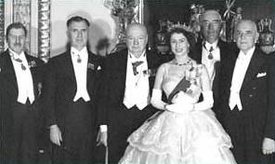Evening dress
|
|

Evening dress (also known as full evening dress) or white tie is the most formal dress code that exists for civilians today.1
There exists a semi-formal counterpart known as black tie and a formal day time equivalent known as morning dress.
A lady must wear a formal ball gown when the dress is described as white tie. Where state decorations are specified, tiaras are usually worn by those women who are married.
| Contents |
Elements
VincentLopezMic.jpg
Evening dress is more strictly regulated than other forms of dress, and properly consists of:
- Black tailcoat with silk (ribbed or satin) facings, sharply cut-away at the front
- Black trousers with two rows of braid down each leg
- White stiff-fronted shirt
- White stiff wing collar (attached to the shirt with collar studs)
- White bowtie
- White low-cut waistcoat
- Black dress socks
- Black formal shoes
Shirts, waistcoats and bow ties are now usually made of cotton marcella, although plain linen shirts and white or off-white silk ties and waistcoats are sometimes worn. Shirt studs and cufflinks should be silver or white. A white handkerchief and flower may be worn. At occasions of state, and in the presence of royalty, state decorations are worn by those who have been awarded them: miniature medals plus up to four breast stars, a narrow neck riband and a broad riband (sash).
Outdoors a black silk plush top hat is appropriate, with an opera cloak or overcoat, even during the summer. White gloves, scarf and cane are optional extras.
Occasions which warrant it
Like black tie, evening dress is generally only worn after 6 p.m. (see note 1 for an exception). Occasions that require white tie are increasingly rare, but in the United Kingdom these still include:
- State dinners (e.g. dinners with visiting heads of state)
- Commemoration balls and May balls at the Universities of Oxford and Cambridge
- Hunt balls
- Some balls during the London Season
In Austria and elsewhere in Continental Europe there are many balls where white tie is worn. In Finland as well as The Netherlands many academic traditions still require white tie. The Nobel Prize ceremony is white tie.
Conductors of an orchestra or symphony playing classical music often are dressed in white tie.
Heaven_Can_Wait(DVDcover).jpg
Related forms of dress
White ties were historically worn by clerics and in the professions that formerly were filled by priests and minor clerics. In various forms they are still worn as part of:
- Clerical dress (by persons in Holy Orders)
- Clerical dress (by clerks etc. in Parliament)
- Court dress (in courts of law)
- Court dress (in the Royal court)
- Academic dress (in the older universities such as Oxford, Cambridge and Durham)
White ties are not worn with military mess dress, where black ties are worn even with the most formal variants. In the Royal Navy, mess dress (as opposed to mess undress) requires a white waistcoat but a black tie.
Note
1 In the United Kingdom civilian day court dress (in the Royal court) is similar to white tie, but nowadays white tie is worn in its place to the most formal state occasions, e.g. by foreign ambassadors at the State Opening of Parliament. This is the case even though such occasions occur during the day.
External links
- Definition of white tie (http://www.cam.ac.uk/societies/cuhags/whitetie/defn.htm)de:Frack
